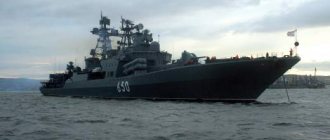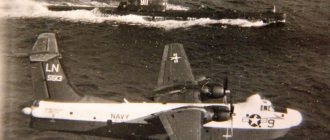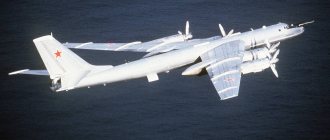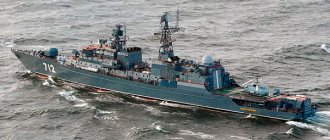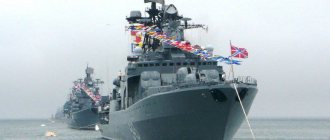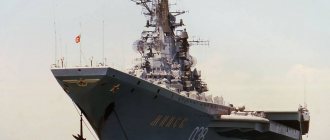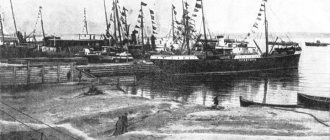Soviet destroyers of the Second World War
Click for ENGLISH language A destroyer is a multi-purpose fast ship designed to combat enemy submarines and ships.
A destroyer can also be used for reconnaissance and patrol services in the interests of the escorted squadron, artillery support during landings and for laying minefields. The main weapons are torpedoes (against large ships), depth charges (against submarines), artillery - against comparable and smaller ships. The tactics of combat use of destroyers consisted of hitting large enemy ships with torpedoes at high speed, making it difficult to destroy them with naval artillery fire. The Soviet Union built destroyers of Project 7, which was replaced by Project 7-U (Improved), and the leaders of the destroyers of Project 38 (Minsk, Baku and Tbilisi) and Project 1 (Leningrad, Moscow and Kharkiv") .
| Performance characteristics of destroyers of the USSR Navy | |||||||||
| type | Built | Displacement standard / full | Crew | Power point | Speed | Artillery weapons | Anti-aircraft weapons | Anti-submarine weapons | Torpedo and mine weapons |
| project 7: type Angry | 28 | 1600 t/ | 246 | 2 PTU GTZA-24, 48000 hp. | 39 knots | 4 * 130 mm B-13-2S | 2 * 76 mm 34-K + 2 * 45 mm 21-K + 4 * 12.7 mm DShK | 2 BMB-1 bomb launchers | 2 * 533 mm TA 39-Yu; sea mines KB-3 |
| Project 7-U: Storozhevoy type | 18 | 1854 t/ | 271 | 2 TZA systems Parsons 54,000 hp | 36.8 knots | 4 * 130 mm B-13-2S | 2 * 76 mm 34-K + 3 * 45 mm 21-K + 4 * 12.7 mm DShK | 2 BMB-1 bomb launchers | 2 * TA 1-N; sea mines KB-3 |
| project 1: Leningrad type | 3 | 2032 / 2693 t | 3 * 66000 hp | 40 knots | 5 * 130 mm B-13-2S | 2 * 76 mm 34-K + 4 * 37 mm 70-K + 4 * 12.7 mm DC | 2 bomb releasers | 2 * 4 * 533 mm TA 53-F; sea mines design bureau | |
| project 38 type Minsk | 3 | 1952 / 2597 t | 3 * 66000 hp | 36 knots | 5 * 130 mm B-13-2S | 3 * 76 mm 34-K + 4 * 37 mm 70-K + 6 * 12.7 mm DC | 2 bomb releasers | 2 * 4 * 533 mm TA 53-F; sea mines design bureau | |
Battles in the Arctic
(mainly actions of destroyers)
Battles in the Black Sea
(mainly actions of destroyers)
Battles in the Baltic
(mainly actions of destroyers)
KBF: Soviet destroyers of Project 7-U (Storozhevoy type) are moving with bearing. Ruski razarac tip 7-U.
Photo. Soviet destroyer of project 7 "Grozny" Soviet development project 7 Soviet leader of destroyers of project 1 "Kharkov". Rusky Torpedoborec.
The leader of the destroyers of Project 20I "Tashkent" of the Black Sea Fleet in 1941. "Tashkent" was laid down on January 11, 1937 on the slipway of the Italian company Odero Temi Orlando by order of the USSR. In May 1939, the leader was transferred to the Soviet Union and in October of the same year joined the Navy. During the war, he actively participated in escorting convoys and transporting various cargoes, conducted up to hundreds of live firing exercises and chalked up 13 aircraft and a torpedo boat. She was sunk by German aircraft in the port of Novorossiysk on July 2, 1942.
Soviet destroyer of the Black Sea Fleet 'Frunze' (formerly 'Bystry').
The captured destroyer of the Black Sea Fleet 'Flying' is a former Romanian Italian-built destroyer 'Regina Maria'. On August 29, 1944, the destroyer was captured by Soviet troops in Constanta.
Project 7 destroyer "Reasonable" RKKF. Svetskiyat destroyer project 7.
The ocean is ahead. My commander is calm - Recklessness and risk are not in his honor. Behind is a caravan, I am a convoy ship, And I must bring my transport home. But I’m cramped in the ranks, and I want a fight, I’m shaking with fever from forecastle to quarterdeck. But an order is an order! I am a convoy ship. This means I don't belong to myself. We've been sailing for three days now, the sun is warming the deck. Not a military campaign, but a luxurious cruise. And the transport relaxed, leaned on the railing, What can you take from civilians? But I'm not a tourist. I know what this silence is worth. I am ready every moment to recognize their patrol. The devices are ready, I am a convoy ship, I know what it means to expose your side. Well, he croaked: “Polundra!” The acoustician gave the bearing. A little to the right of the course, the noise of the propellers cut into the night. Have fun, guys, don’t give in to sadness, I’ve been waiting for this moment and I can help you! We'll catch up with her. But why? What's happened? Why “stop the car!” and I’m lying in a drift? Why am I not free? Why am I in a convoy? Why don't I belong to myself? The base salutes us with the thunder of hundreds of guns. We identified ourselves, I guess, I was walking like a sheep. I never chased an enemy at sea, nor did I stand up to the end in a fierce battle. Who will save my honor? Who will wash them with blood? Commander, I ask you to look into my eyes. And he said in response: “You are a convoy ship. We’ve reached it, so you’ve proven everything!” Alexander Rosenbaum
Soviet fleet of World War II
Cruisers Battleships Submarines Hunters Minesweepers Minzags Patrol boats Boats
Start
?>
Construction of Soviet 3rd generation destroyers
In June 1975, at the shipyard named after. Zhdanov, in a solemn ceremony, the laying of the lead ship of the project, the destroyer Sovremenny, took place. Evaluating the drawings and scale of construction, one could judge the impressive dimensions of the new ship. The destroyer's design displacement was 6,500 tons with a hull length of 156 meters and a width of 17.2 meters.
The new ship was a large combat unit, which, when commissioned, could significantly strengthen any navy. However, a year after the laying of the lead ship, Project 956 was revised, and it was decided to limit the series to 32 units. Already at the end of the 80s, serial construction of Soviet 3rd generation destroyers was limited to 20 units. New combat ships were built for the needs of the Soviet Navy. Only after the collapse of the Soviet Union were some unfinished ships completed at Russian shipyards.
Already during the construction process, in order to increase the pace of commissioning of the fleet of new destroyers, an attempt was made to begin building ships in Nikolaev (Ukraine). After the transfer of technical and design documentation to the Nikolaev plant named after. 61 Communards, the laying of two ships took place, but with the beginning of perestroika, further construction was suspended. The mothballed hulls of the destroyers “Impressive” and “Eternal”, in varying degrees of readiness, were purchased from Ukraine by the Chinese side after the division of the USSR naval economy. Today these are active ships of the Chinese Navy, the destroyers Taizhou and Ningbo.
Three ships of the improved project 956-A “Bespokoiny”, “Nastochivyy” and “Besstrashny” were subsequently commissioned into service in the Baltic and Northern fleets and continue to remain in the active fleet. Together with them, the destroyer “Bystry”, the 11th ship in the series, continues to carry out combat service. Four other ships, the hulls of which were laid down during the Soviet period, were sold to China and were completed as part of the export option for the needs of the Navy of the People's Republic of China.
All other ships of the project built in 1980-91 have now been withdrawn from the active fleet. Most of the ships, including the lead ship of the Sovremenny series, have already been disposed of or are awaiting their fate.
Main features of the new Soviet destroyers of Project 956
The new warships, which began to be supplied to the fleet in 1978, were quite impressive combat units. Until that time, there were no ships of this class in the Soviet navy. Even a superficial inspection of the vessel made an impression and spoke of its high combat capabilities and tactical and technical characteristics. The ship had:
- helipad for Ka-27 helicopter;
- universal anti-aircraft missile system "Hurricane";
- anti-ship missile system "Moskit" (2 launchers);
- turret artillery mounts 130 mm guns (2x2).
The ships were equipped with new gas turbine power plants, which provided the ship with high speed and a fairly impressive cruising range. The destroyer's maximum speed was 33.4 knots. The cruising range at an economical 18 knot speed was almost 4000 miles.
Based on the data provided, the new Project 956 destroyer was supposed to be capable of performing the following functions:
- destruction of enemy ships on the high seas and in the area of operation of the naval landing forces;
- fire support for landing operations, suppression of enemy resistance to operational depth;
- ensuring stable air defense and anti-aircraft defense of the landing order during sea crossings and during landing operations.
In addition to effective and powerful fire weapons, the ship had modern radar equipment, which made it possible not only to timely detect sea and air targets, but also to conduct active electronic warfare. This entire mass was served by a crew of 300 people, of which a third were officers and midshipmen.
For the construction of Sarych-class destroyers, assembly technology that was innovative at that time was used. The hulls were formed in a sectional manner, starting from the keel part and ending with the installation of fragments of the engine and boiler room. This made it possible to obtain ship hulls of a high degree of readiness in the shortest possible time. The hulls were built on an open slipway, while subsequent assembly and installation of the vessel's filling was carried out in a closed slipway.
The ship's hull was made of low-alloy steel, while the upper superstructures were mainly assembled from aluminum alloy.
Despite the sheer hull, the ship had 6 straight decks parallel to the waterline. The interior space of the destroyer was divided into 16 compartments. Such hull contours made it possible to significantly increase the seaworthiness of the vessel. The upper part of the hull and the design of the superstructures were created taking into account the convenient placement of the ship's main onboard weapons and reducing the visibility of the ship's silhouette in radar fields.
The propulsion system of the 3rd generation Soviet destroyers was represented by the GTZA-674 gas turbine units. The total capacity of the two units was 100 thousand l/s. The propulsion group had a variable speed setting for the propellers. The power plant not only ensured the propulsion of the ship, but also ensured the power supply to all the main systems of the ship.
Armament of Soviet destroyers of Project 956 using the example of the Bystry ship
The armament of Soviet destroyers deserves a separate discussion. Due to the lengthy development of the project and the introduction of changes during the construction of the ship, it was possible to create a ship superior to the American Spruance-class destroyers. In terms of seaworthiness, Soviet ships had no equal and could easily withstand waves of up to 7 points. As for weapons, the Sarych-class destroyers did not leave their counterparts any chance in terms of strike weapons.
The American managed to achieve an advantage in another direction. The Spruances had better air defense and anti-submarine warfare systems. The availability of more modern radar and hydroacoustic equipment in the United States, which was installed on new ships, had an impact. Only in the mid-80s, when launch containers for Tomahawk cruise missiles began to be installed on the Spruances, their strike capabilities increased significantly and reached their Soviet counterparts.
Despite the fact that Project 956 was created as a counterweight to the American Spruance-class destroyers, more modern and technologically advanced American Arleigh Burke-class destroyers became a potential enemy of Soviet ships at sea. Soviet destroyers were inferior to this enemy in many respects, which affected the rapid curtailment of mass production. However, with a competent approach, the design of Soviet ships provided ample opportunities for subsequent modernization, which was done already in the post-Soviet period. When replacing the basic systems of radar and hydroacoustic equipment with more advanced ones, the ships can be equipped with new weapons, including the Onyx and Caliber anti-ship systems.
As for the state of armament of Soviet-era ships, this can be seen today when examining the destroyer “Bystry”. This is the only serial ship that was completely built back in the Soviet era and initially retained all the parameters inherent to this project.
The main strike weapon is the same anti-aircraft missile system "Moskit", equipped with supersonic missiles P-270 "Moskit". The rocket could deliver 300 kg. warhead at a distance of 90-150 km, depending on modification. In this case, the carrier’s flight speed was 470 m/s. The ship carried 8 such missiles installed in two four-section containers, two on each side.
In addition to the anti-ship complex, the destroyer "Bystry" had four 130-mm guns, located two in two turrets, in the bow and in the stern. The firing range of the guns was 23 km. In automatic mode, AK-130 artillery mounts could fire up to 6 tons of shells at a target within one minute. Such powerful artillery weapons allowed Soviet destroyers to successfully operate at sea in close encounters with enemy ships. As for the ship's artillery as a means of fire support for ground operations, the ship's firepower was unsurpassed.
Classification and definition
Classification, technical characteristics and a brief description of warships will help determine the differences between such military equipment.
Corvette
In the recent history of the Russian Navy, such a combat unit as the corvette is just beginning its intensive development, despite the fact that the first representatives of this class appeared back in the 17th century. At that time, a corvette was a three-masted ship that had straight sails and 20-30 guns located on the upper deck. The function of such military equipment was reconnaissance and transportation of secret mail.
The displacement of the first corvettes ranged from 460 tons and above. In the mid-20th century, wheeled and sail-screw models appeared. With the beginning of the development of missile weapons, ships began to be equipped with missile launchers.
Expert opinion
Karnaukh Ekaterina Vladimirovna
Graduated from the National University of Shipbuilding, majoring in Enterprise Economics
The task of modern corvettes, which are in service with many countries around the world, is anti-submarine defense of a convoy or strategic coastal facility. At the end of the 80s of the last century, such combat units began to be equipped with sonar stations and torpedo tubes. The displacement of modern corvettes has increased to 1200-1500 tons. The ships' armament was also supplemented with light helicopters, used for target designation of anti-ship missiles.
Destroyer
In naval terminology, a destroyer is a maneuverable and fast warship characterized by high strength. The purpose of such a combat unit is to escort and protect a convoy, large fleet vessels or battle groups from powerful short-range attacks.
The first units of such warships were developed in the last decade of the 19th century. The designer of the destroyers was the Spaniard Fernando Villamil. The equipment was intended to protect the Spanish navy and merchant fleet from torpedo boats. At the start of the Russo-Japanese War, such ships were fast, powerful and well-armed combat units that were used to destroy enemy torpedo boats.
Destroyers are more compact in size than battleships; as a rule, ships are armed with one cannon and many missiles, including anti-ship missiles. Modern combat units are often equipped with a helipad, which allows for more effective anti-submarine warfare. The displacement of modern destroyers ranges from 3,000 to 10,000 tons.
Frigate
In Russia, the first ships called frigates appeared during the reign of Peter I. Moreover, this word was used to describe all naval units performing cruising functions, regardless of the presence or absence of sailing weapons.
With the outbreak of World War II, a change in the classification of warships occurred. To escort convoys, they began to use specially designed combat units, which were called differently in different countries - frigates, escort destroyers, patrol ships or escort ships. In terms of their displacement, such ships occupied an intermediate position between corvettes and destroyers. Military equipment was equipped with anti-submarine, powerful cannon and anti-aircraft weapons.
Expert opinion
Karnaukh Ekaterina Vladimirovna
Graduated from the National University of Shipbuilding, majoring in Enterprise Economics
Today, the Russian Navy has two types of patrol ships, which are classified as frigates. They are designed to protect the battle fleet and convoy from light surface forces, as well as enemy submarine and air forces in the far sea zone. Thus, according to the Russian classification, former large anti-submarine and patrol ships of the far sea zone, as well as universal patrol units, are called frigates.
Cruiser
Cruisers are a class of military sea ships, they are capable of performing a wide range of tasks and are independent from the rest of the fleet. The term first began to be used in the 17th century. The word cruiser meant a combat unit that operated independently of the rest of the fleet. This rather indicated the class of the vessel rather than its design features and technical characteristics. Small, fast ships were used as cruisers at that time. In the 18th century, frigates became cruisers - fast and maneuverable ships with a small amount of weapons.
A modern cruiser is an expensive product that is created using shipbuilding, electronic and missile technologies. Only large states can afford such ships; today such a combat unit is only in service with Russia and the United States. The ships are used to combat light forces of the enemy fleet and merchant ships, as well as to defend combat formations and convoys.
Battleships
A battleship, or battleship, is a class of the most powerful armored artillery combat units in service with various countries in the 20th century. Before WWII, such warships were considered a symbol of the power of naval powers, as well as a means of ensuring supremacy at sea. Their displacement could exceed 80,000 tons.
Battleships were used to destroy enemy ships and as artillery support for land operations. Before the outbreak of World War II, such combat units were available in the fleets of all major naval powers, but during WWII operations they did not live up to the hopes placed on them. The fact is that battleships turned out to be vulnerable to attacks from aircraft and submarines. Because of this, their production completely ceased at the end of the 40s. Today, there are no such combat units in the world's fleets.
Aircraft carriers
This class of warships, such as aircraft carriers, are designed to be based in a port and for combat use in water areas. We can say that such a ship is an airbase that operates on the high seas. The main difference between aircraft carriers and other warships is that they are equipped with a flight deck and other facilities that facilitate the take-off, landing and deployment of combat aircraft and helicopters.
As defensive weapons, aircraft carriers are equipped with small and medium caliber anti-aircraft artillery, as well as guided missiles. However, in the second half of the 20th century, due to the development of missile weapons, the strategic importance of these ships decreased significantly.
The tasks of aircraft carriers include the following:
- anti-submarine and anti-aircraft protection of naval units;
- air support for ground operations taking place in the coastal zone;
- gaining local air superiority and destroying enemy air defenses.
There are three classes of aircraft carriers: light, medium and heavy. The displacement of ships (depending on the class) ranges from 30,000 to 100,000 tons.
